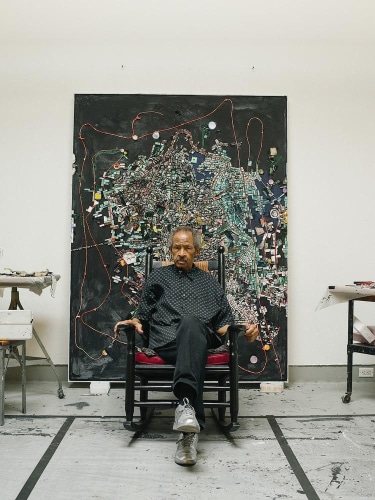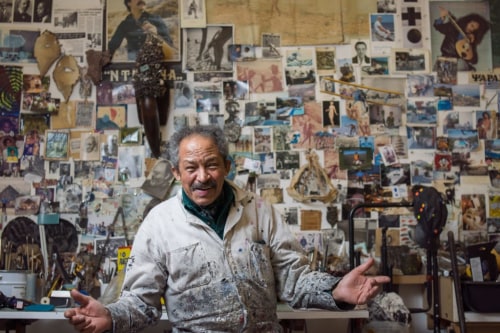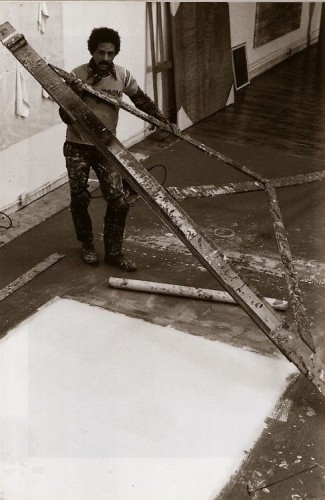Jack Whitten
Barney's Legacy II, 1980
Jack Whitten
“I was 21 in 1960, an African American male with an acute need to know myself. The politics of race accelerated my search for identity. Growing up in the South where I experienced racism in its most blatant forms, political boundaries were clearly drawn and based solely upon race. Diverse elements, opposing forces, dichotomy of means, polarities, [and] portraits of psychological space are conceptualizations used in my paintings. All are derived from the nature of politics in America with its distinct separation of black and white.” - Jack Whitten

Artist Jack Whitten in front of an unfinished work at his studio in New York City. Photo by Mark Hartman for WSJ Magazine. Artwork © 2020 Estate of Jack Whitten.
Jack Whitten’s (1939-2018) processed-based abstractions have made him one of his generation's most innovative artists. Known for developing new tools and methods of paint handling that allow for creative ways of applying paint to canvas, Whitten’s technical advances impart an importance of materiality onto his work that underscores his compositions' spiritual elements. Barney’s Legacy II, painted in 1980, is one such example of Whitten’s ability to distill many influences into a single, mystical work of art.
The 1980s were a moment of essential shifts in Whitten’s practice. In the late 1970s, Whitten worked on his Greek Alphabet series, a grouping of works utterly devoid of color. It wasn’t until around the time Whitten painted Barney’s Legacy II that he began to reintroduce color into his painting slowly. Viewers can see Whitten's hesitation to completely open the canvas back up to pigment's possibilities in two ways: his strict use of primary colors in the spaces he does choose to embellish, and how many of these hues seems to be revealed from underneath the white ground as if slowly poking their heads above the surface. This renewed interest in color stemmed, in part, from his wife’s work at Nelson Whitehead, the largest importer of artist-grade papers. Whitten fell in love with the brightly colored Japanese papers they carried, and he began experimentally implementing them into his paintings or using them as jumping-off points. These geometric punctuations work in tandem with the lyrical swirls that surround them, recalling Whitten’s foundation in Abstract Expressionism, which formed during his early years in New York under the mentorship of Willem de Kooning and Norman Lewis. The freedom of movement and sense of improvisation elicited in the relationship between the blunt, accentuated forms and expressive strokes similarly evoke Whitten’s deep love and appreciation for jazz music.

Artist Jack Whitten in his studio, 2016. Photo by Taylor Dafoe.
Indeed, the geometric forms stand out in Barney’s Legacy II from a purely visual standpoint. Still, they also play a vital function in linking this painting to Whitten’s broader interest in mosaics. Having spent his summers on the Greek island of Crete since the late 1960s, Whitten had the opportunity to view countless Byzantine mosaics in the surrounding areas. He had a particularly life-altering experience while in Egypt celebrating Greek Christmas at Saint Catherine’s Monastery. The light from the candles used in the ceremony gradually illuminated the mosaics surrounding the churchgoers, creating a mood Whitten has described as transcendental. These experiences would percolate as one of many influences he pulled from when creating his paintings. Whitten eventually formulated his own method of producing acrylic tesserae, the tiny tiles that make up a larger mosaic. While this would take fuller form in the following years, Barney’s Legacy II exhibits hints of Whitten moving in that direction and underscores how deeply he felt his influences. The connection between mosaics and jazz had first occurred to Whitten in 1965 when he first met jazz musician John Coltrane and realized through his music that “I was looking for light—light in painting.”

Jack Whitten in his studio with his “developer.” Photographer unknown.
While Whitten is undeniably an abstractionist, one of the core tenants of his practice is the belief that formalism is merely a means to an end. Decidedly moving away from the Greenbergian philosophies that were still very much dominant upon Whitten’s arrival in New York in 1960, he saw abstraction as a vehicle to channel the essence of a life, an experience, or an idea, into a meditative and spiritual realm. For as much attention as Whitten paid to his surfaces' materiality, he gave just as much credence to the thoughts and feelings behind the forms. This interest in spiritual essence took on particular importance in the 1980s, the decade to which Barney’s Legacy II belongs. Uniting Whitten’s work from the period 1979 - 1989 is a process analogous to electronic imaging and photography. Inspired by the new scientific and technological advancements of the time, including cathode-ray scanning and electron microscopy, Whitten began to think of his painting as a transmission process, where the subjective qualities of a time, place, or person are distilled into a repeatable unit. This thought process furthered his tendency to dedicate works to specific notable figures, such as James Baldwin, Norman Lewis, or Martin Luther King Jr., an exercise particularly common during this decade. Although the identity is not definitively known, the title Barney’s Legacy II places this painting in a realm alongside Whitten’s “memorial” paintings and his Black Monolith series. With these factors coalescing in Barney’s Legacy II, this painting embodies the most crucial tenants of Whitten’s endlessly innovative practice.
"Jack Whitten: An Artist's Life," 2018. From Art21’s Extended Play series. Video courtesy Art21, art21.org, founded 1997.
“Every painter, whether they’re abstract or figurative, has to discover that the only light they’ve got is in color. I don’t care about all the other stuff that people attach to it—the politics, the social issues—O.K. in terms of contemporary thought and the world we live in, I won’t say that’s not important. But ultimately, it’s what’s in the tube of paint that matters.” - Jack Whitten





